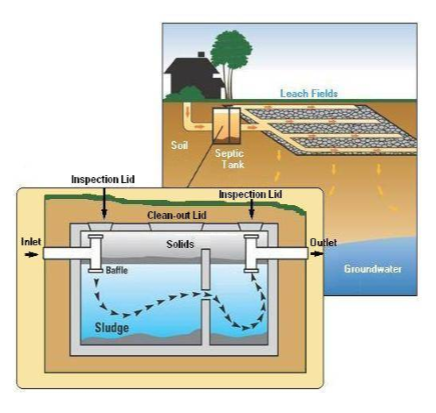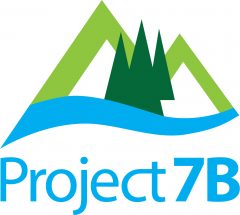
When a home is not hooked up to a public sewer system it will most likely require construction of an on-site septic system to manage the waste water from household toilets, sinks, showers, and laundry. A basic septic system is made up of a septic tank and an underground drainfield. Within the septic tank waste will separate with the solids sinking to the bottom of the tank, where they are consumed by anaerobic bacteria, and liquids remaining suspended in the tank where they flow out to the dranfield when new wastewater enters the tank. The liquid flows out of drainpipes through drain rock and into the soil. Drainfields will likely fail at some point in time and therefore it is necessary to have a backup drainfield site defined previous to building.
Septic systems use the environment–microbes in the soil and evapotranspiration–to treat wastewater that flows from the septic tank. Both the activity of the microbes and evapotranspiration require the flow of air and oxygen. If a permanent structure is built over a drainfield, the structure can restrict the oxygen flow into the soil, hampering these natural processes. This means that inadequately treated wastewater, along with some offensive odors, could flow into your backyard and potentially contaminate other water sources, such as a nearby lakes and streams, or even groundwater.
Human wastewater contains disease-carrying organisms and can transfer diseases such as dysentery, hepatitis, and typhoid fever to humans and animals. An improperly-working septic system may release untreated or partially treated wastewater if the system fails. Failing systems also leak excessive nutrients and bacteria to streams and lakes, destroying plant and animal habitat, closing beaches, and causing excessive growth of aquatic invasive plants and algae.
Building over a drainfield can also cause the lines to collapse. Alternatively, the soil can compact around the trenches, which may not allow for percolation. Repairing the drainfield or moving it may require an entirely new system, which would be a significant expense for the property owner.
The Idaho Department of Environmental Quality has defined minimum standards for septic systems in order to retain our water quality and keep drinking water safe. These rules are administered by Idaho’s public health districts which is the Panhandle Health District (PHD) here in Bonner County. PHD is not a part of a state agency and does not receive state funding for implementation of Idaho’s minimum standards for septic systems. For a fee PHD reviews sites for suitability and placement of septic systems and drainfields, as well as, issuing septic permits and inspecting installed systems. If you would like to read more about septic systems please refer to the Idaho Department of Environmental Quality’s website page Onsite Wastewater Systems.
